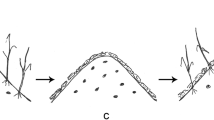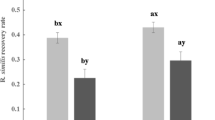Abstract
A previous field trial showed that marketable yield increased and root-knot nematode populations declined when the swollen roots of sweetpotato were surrounded by a sawdust-based amendment. Further evidence that such amendments provide worthwhile levels of nematode control was obtained in this study. Customised pots filled with an organic amendment or amended soil were kept in a greenhouse or buried in the field for various times and then the nematode-control potential of various treatments was assessed by surrounding the pots with soil infested with Meloidogyne incognita. Swollen root production generally increased, and root-knot nematode populations consistently declined, when sawdust was used as an amendment. The addition of an organic nitrogen source generally improved the level of control. Laboratory and greenhouse assays confirmed that amended soils were biologically suppressive, as root-knot nematode numbers were lower and fewer galls were produced in soil containing decomposing amendments than in soil or sand that had been heated to kill the soil biota. A predatory nematode morphologically similar to Clarkus papillatus was one of the suppressive agents as numbers were very high in some experiments. Mesostigmatid mites in the family Laelapidae and genera Sejus, Protogamasellus, Holaspulus and Gamasiphis were also contributing, while an acarid mite (Rhizoglyphus robini) occurred in high numbers and was observed devouring root-knot nematode juveniles on agar plates. Nematophagous fungi were also involved as three species of nematode-trapping fungi (Arthrobotrys musiformis, A. thaumasia and A. oligospora) and an unidentified fungus that captures nematodes on bulbous hyphal extensions were consistently isolated from amended soils. These results suggest that sawdust-based amendments enhance the nematode-suppressive services provided by a wide range of predators.






Similar content being viewed by others
References
Akhtar M, Malik A (2000) Roles of organic soil amendments and soil organisms in the biological control of plant-parasitic nematodes: a review. Bioresour Technol 74:35–47
Bell NL, Adam KH, Jones RJ, Johnson RD, Mtandavari YF, Burch G, Cave V, Cameron C, Maclean P, Popay AJ, Fleetwood D (2016) Detection of invertebrate suppressive soils, and identification of a possible biological control agent for Meloidogyne nematodes using high resolution rhizosphere microbial community analysis. Front. Plant Sci 7, article 1946. doi:https://doi.org/10.3389/fpls.2016.01946
Bonanomi G, Lorito M, Vinale F, Woo SL (2018) Organic amendments, beneficial microbes, and soil microbiota: toward a unified framework for disease suppression. Annu Rev Phytopathol 56:1–20
Bouwman LA, Bloem J, van den Boogert PHJF, Bremer F, Hoenderbloom GHJ, de Ruiter PC (1994) Short-term and long-term effects of bacterivorous nematodes and nematophagous fungi on carbon and nitrogen mineralization in microcosms. Biol Fert Soils 17:249–256
Bremner JM (1965) Nitrogen availability indexes. In: Black CA (ed) Methods of soil analysis part 2. American Society of Agronomy, Madison
Bünemann EK, Bongiorno G, Bai Z, Creamer RE, De Deyn G et al (2018) Soil quality- a critical review. Soil Biol Biochem 120:105–125
Chen J, Ferris H (2000) Growth and nitrogen mineralization of selected fungi and fungal-feeding nematodes on sand amended with organic matter. Plant Soil 218:91–101
Chinivasagam HN, Redding M, Runge G, Blackall PJ (2010) Presence and incidence of food-borne pathogens in Australian chicken litter. Br Poult Sci 51:311–318
Clarholm M (1985) Interactions of bacteria, protozoa and plants leading to mineralization of soil nitrogen. Soil Biol Biochem 17:181–187
Díaz A, Okabe K, Eckenrode CJ, Villani MG, OConnor BM (2000) Biology, ecology, and management of the bulb mites of the genus Rhizoglyphus (Acari: acaridae). Exp Appl Acarol 24:85–113
Fan Q-H, Zhang Z-Q (2003) Rhizoglyphus echinopus and Rhizoglyphus robini (Acari: acaridae) from Australia and New Zealand: identification, host plants and geographical distribution. Syst Appl Acarol Special Publications 16:1–16
Ferris H, Venette RC, van der Meulen HR, Lau SS (1998) Nitrogen mineralization by bacterial-feeding nematodes: verification and measurement. Plant Soil 203:159–171
Gannett M, Pritts MP, Lehmann J (2019) Soil amendments affect soil health indicators and crop yield in perennial strawberry. HortTechnology 29:179–188
Gray NF (1987) Nematophagous fungi with particular reference to their ecology. Biol Rev 62:245–304
Hoitink HAJ, Stone AG, Han DY (1997) Suppression of plant diseases by composts. HortScience 32:187
Huhta V, Siira-Pietikäinen A, Penttinen R (2012) Importance of dead wood for soil mite (Acarina) communities in boreal old-growth forests. Soil Org 84:499–512
Ingham RE, Trofymow JA, Ingham ER, Coleman DC (1985) Interactions of bacteria, fungi, and their nematode grazers: effects on nutrient cycling and plant growth. Ecol Monogr 55:119–140
Jeffrey JS, Lazano JC, Atwill ER, Walton EH (2001) Thermal events and physical characteristics of simply stacked poultry litter: implications for microbial safety. Proc. 50th Western Poultry Disease Conference, 139-140
Joharchi O, Nazari A, Halliday B, Ostovan H (2015) Observations on predation of Rhizoglyphus robini (Acari: acaridae) on the alfalfa stem nematode, Ditylenchus dipsaci (Nematoda). Persian Journal of Acarology 4:329–335
Kamczyc J, Gwiazdowicz DJ, Teodorowicz E, Strzyminska K (2014) Mites (Acari, Mesostigmata) in boreal scots pine forest floors: effect of distance to stumps. Exp Appl Acarol 64:61–71
Kaplan M, Noe JP (1993) Efects of chicken-excrement amendments on Meloidogyne arenaria. J Nematol 25:71–77
Lahm GP, Desaeger J, Smith BK, Pahutski TF, Rivera MA, Meloro T, Kucharczyk R, Lett RM, Daly A, Smith BT, Cordova D, Thoden T, Wiles JA (2017) The discovery of fluazaindolizine: a new product for the control of plant parasitic nematodes. Bioorg Med Chem Lett 27:1572–1575
Lehman RM, Cambardella CA, Stott DE, Acosta-Martinez V, Manter DK, Buyer J, Maul J, Smith J, Collins H, Halvorson J, Kremer R, Lundgren J, Ducey T, Jin V, Karlen D (2015) Understanding and enhancing soil biological health: the solution for reversing soil degradation. Sustainability 7:988–1027
McSorley R (2011) Overview of organic amendments for management of plant-parasitic nematodes, with case studies from Florida. J Nematol 43:69–81
Muller R, Gooch PS (1982) Organic amendments in nematode control. An examination of the literature Nematropica 12:319–326
Norris CE, Congreves KA (2018) Alternative management practices improve soil health indices in intensive vegetable cropping systems: a review. Front Environ Sci 6, Article 50, 1–18
Oka Y (2010) Mechanisms of nematode suppression by organic soil amendments- a review. Appl Soil Ecol 44:101–115
Osler GHR (2003) Impact of soil fauna on chemical transformations in soil. In: Abbott LK, Murphy DV (eds) Soil biological fertility- a key to sustainable land use in agriculture. Kluwer, Amsterdam, pp 17–35
Rayment GE, Lyons DJ (2011) Soil chemical methods –Australasia. CSIRO Publishing, Melbourne
Riegel C, Noe JP (2000) Chicken litter soil amendment effects on soilborne microbes and Meloidogyne incognita on cotton. Plant Dis 84:1275–1281
Rosskopf E, Di Gioia F, Hong JC, Pisani C, Kokalis-Burelle N (2020) Organic amendments for pathogen and nematode control. Annu Rev Phytopathol 58:277–311
Runge GA, Blackall PJ, Casey KD (2007) Chicken litter. Issues associated with sourcing and use. Rural Industries Research and Development Corporation, RIRDC publication no. 07/036
Sanchez-Moreno S, Ferris H, Guil N (2008) Role of tardigrades in the suppressive service of a soil food web. Agr Ecosyst & Environ 124:187–192
Stirling GR (2014) Biological control of plant-parasitic nematodes: soil ecosystem management in sustainable agriculture. CAB International, Wallingford
Stirling GR, Hayden HL, Pattison AB, Stirling AM (2016) Soil health, soil biology, soilborne diseases and sustainable agriculture. A guide. CSIRO Publishing, Melbourne
Stirling GR, Stirling AM, Prichard M (2020) Sustainable sweetpotato farming systems to improve soil health and reduce losses caused by root-knot nematodes. Australas Plant Pathol. 49:591–604 https://doi.org/10.1007/s13313-020-00731-7
Stirling GR, Stirling AM, Walter DE (2017) The mesostigmatid mite Protogamasellus mica, an effective predator of free-living and plant-parasitic nematodes. J Nematol 49:327–333
Stirling GR, Wilson EJ, Stirling AM, Pankhurst CE, Moody PW, Bell MJ, Halpin N (2005) Amendments of sugarcane trash induce suppressiveness to plant-parasitic nematodes in sugarcane soils. Australas Plant Pathol 34:203–211
Taranet P, Harper S, Kirchhof G, Fujinuma R, Menzies N (2017) Growth and yield response of glasshouse- and field-grown sweetpotato to nitrogen supply. Nutr Cycl Agroecosyst 108:309–321
Thoden TC, Alkader MA, Wiles JA (2020) Biological attributes of Salibro™, a novel sulphonamide nematicide. Part 2. Impact on the fitness of various non-target nematodes. Nematology 22 DOI https://doi.org/10.1163/15685411-bja10041
Thoden TC, Korthals GW, Termorshuizen AJ (2011) Organic amendments and their influences on plant-parasitic and free-living nematodes: a promising method for nematode management? Nematology 13:133–153
Topalovic O, Hussain M, Heuer H (2020) Plants and associated soil microbiota cooperatively suppress plant-parasitic nematodes. Front. Microbiol 11, article 313. doi: https://doi.org/10.3389/fmicb.2020.00313
Walter DE, Ikonen EK (1989) Species, guilds and functional groups: taxonomy and behaviour of nematophagous microarthropods. J Nematol 21:315–327
Walter DE, Kranz GW (2009) Collecting, rearing and preparing specimens. In: Kranz GW, Walter DE (eds) A manual of acarology, 3rd edn. Texas Tech University Press, Lubbock, pp 83–96
Walter DE, Proctor H (2013) Mites: ecology, evolution and behaviour: life at a microscale, 2nd edn. Springer, Berlin
Walter D, Stirling GR (2018) Microarthropods in Australian sugarcane soils: a survey with emphasis on the Mesostigmata as potential regulators of nematode populations. Acarologia 58:673–682
Watson TT, Strauss SL, Desaeger JA (2020) Identification and characterization of Javanese root-knot nematode (Meloidogyne javanica) suppressive soils in Florida. Appl Soil Ecol 154:103597. https://doi.org/10.1016/j.apsoil.2020.103597
Weidemann SG (2015) Land application of chicken litter: A guide for users RIRDC Publication No 14/094
Wolf B, Snyder GH (2003) Sustainable soils. The place of organic matter in sustaining soils and their productivity. Food Products Press, New York
Whitehead AG, Hemming JR (1965) A comparison of some quantitative methods of extracting small vermiform nematodes from soil. Ann Appl Biol 55:25–38
Yeates GW (2003) Nematodes as soil indicators: functional and biodiversity aspects. Biol Fert Soils 37:199–210
Acknowledgments
Many thanks to Dr. David Walter for identifying the mites and Dr. Marcelle Stirling for her help with the nematode community analyses. Matthew Prichard, a sweetpotato grower from Cudgen, NSW contributed by providing the soil and organic amendments used in this study. The chemical analyses were done by staff of the Queensland Department of Environment and Science and the late Dr. Phil Moody (University of Queensland) helped interpret the results.
Author information
Authors and Affiliations
Corresponding author
Rights and permissions
About this article
Cite this article
Stirling, G. Surrounding the swollen roots of sweetpotato with a decomposing band of an organic amendment enhances nematode-suppressive services and reduces damage caused by root-knot nematode. Australasian Plant Pathol. 50, 151–168 (2021). https://doi.org/10.1007/s13313-020-00751-3
Received:
Accepted:
Published:
Issue Date:
DOI: https://doi.org/10.1007/s13313-020-00751-3




